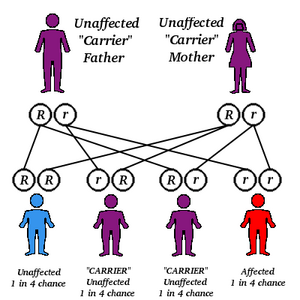Definition
Fanconi's syndrome is a set of kidney malfunctions brought about by a variety of seemingly unrelated disorders. Kidney malfunction leads to excessive urine production and excessive thirst, resulting in deficits of water, calcium, potassium, magnesium, and other substances in the body. It often leads to bone disease and stunted growth.
Description
Normally, kidneys cleanse the blood and keep its salt, water, and acidity in balance, leaving what the body needs in the blood and putting what the body doesn't need into the urine, which leaves the body. This task is performed in two steps. First, the blood is filtered through a kidney structure with small holes that keep the cells and large molecules in the blood. Second, some of the small molecules in the filtrate, needed by the body, are reabsorbed and returned to the bloodstream.
This reabsorption step is defective in Fanconi's syndrome. As a consequence, substances that are normally reabsorbed, like glucose, amino acids, small proteins, water, calcium, potassium, magnesium, bicarbonate, and phosphate, are lost and the body becomes overly acidic.
Fanconi's syndrome is also known as Fanconi syndrome, renal Fanconi syndrome, Fanconi renaltubular syndrome, and Lignac-de Toni-Debré-Fanconi syndrome. Fanconi's anemia is, however, a totally different disease.
Causes & symptoms
Causes
Fanconi's syndrome can be caused by a variety of genetic defects and by certain environmental assaults.
The genetic diseases known to give rise to Fanconi's syndrome are cystinosis (the most common cause in children), galactosemia, glycogen storage disease, hereditary fructose intolerance, Lowe syndrome, Wilson disease, tyrosinemia, medullary cystic disease, vitamin D dependency, and familial idiopathic Fanconi's syndrome.
Environmental assaults that cause Fanconi's syndrome include exposure to heavy metals (like cadmium, lead, mercury, platinum, uranium), certain drugs (like outdated tetracycline and gentamicin), other substances (like Lysol, paraquat, toluene, the amino acid lysine taken as a nutritional supplement), and kidney transplantation.
Symptoms
Fanconi's syndrome symptoms related directly to impaired absorption include excessive urine production and urination; excessive thirst; dehydration; constipation; anorexia nervosa; vomiting; elevated levels of glucose, phosphate, calcium, uric acid, amino acids, and protein (especially beta2-microglobulin and lysozyme) in the urine; elevated levels of chloride and decreased levels of phosphate and calcium in the blood; and excessively acidic blood.
The most noticeable indirect consequences of impaired reabsorption are the bone diseases, rickets and osteomalacia. Rickets affects children and is associated with bone deformities, failure to grow, and difficulty walking. If a person acquires Fanconi's syndrome as an adult, the bone disease is termed osteomalacia and is accompanied by severe bone pain and spontaneous fractures. Unlike rickets due to malnutrition, these diseases cannot be reversed with vitamin D. Muscle weakness and occasional paralysis are other indirect consequences of the ineffective reabsorption.
Diagnosis
Diagnosis of Fanconi's syndrome can be made by urine and blood tests. It is also important to find the underlying cause to decide on the best treatment. Other symptoms specific to a particular patient will point to other useful diagnostic tests. For example, high levels of blood galactose in conjunction with symptoms of Fanconi's syndrome indicate the patient is suffering from galactosemia, while high blood levels of cadmium indicate the patient is suffering from cadmium poisoning.
Treatment
Fanconi's syndrome is best treated by attacking the underlying cause whenever possible. For example, when cystinosis is treated with the drug cysteamine to lower cystine levels in the body or Wilson disease is treated with penicillamine to lower the levels of copper, accompanying symptoms of Fanconi's syndrome will subside. If the patient has acquired the disease from a heavy metal or another toxic agent, all contact with the toxic agent should stop; the condition will then likely disappear.
Nevertheless, additional treatment will be necessary either when it's not possible to treat the underlying cause or while waiting for the kidneys to resume normal function. This is done by restricting sodium chloride (table salt), giving antacids to counteract the excessive acidity of the blood, and supplying potassium supplements.
Kidney transplant is the treatment of last resort, used for patients whose kidneys have failed.
Prognosis
Fanconi's syndrome can be reversible. Fanconi's syndrome caused by kidney transplantation usually reverses itself within the first year after transplant surgery. When caused by a toxin in the environment, Fanconi's syndrome generally can be reversed by removing the causative agent from the patient's environment. If it is caused by a genetic disease, it can usually be reversed by treating the disease. However, if Fanconi's syndrome is not treated or if treatment is unsuccessful, the kidneys can fail.
Prevention
Fanconi's syndrome caused secondarily by the genetic diseases galactosemia, glycogen storage disease, hereditary fructose intolerance, and tyrosinemia is prevented by appropriate dietary restrictions to treat the genetic disease, starting in infancy.
Fanconi's syndrome caused by heavy metals and other toxins can be prevented by avoiding these substances.
Key Terms
- Acidosis
- Condition where the body is more acidic than normal; associated with headache, nausea, vomiting, and visual disturbances.
- Fanconi's anemia
- An inherited form of aplastic anemia.
- Filtrate
- The part of filtered material that flows through the filter.
- Idiopathic
- Refers to a disease of unknown cause.
- Polydipsia
- Excessive thirst.
- Polyuria
- Excessive production of urine.
Further Reading
For Your Information
Books
- Bergeron, Michael, André Gougoux, and Patrick Vinay. "The Renal Fanconi Syndrome." In The Metabolic and Molecular Bases of Inherited Disease, 7th ed., edited by Scriver, Charles R., et al. New York: McGraw-Hill, 1995.
Organizations
- The American Society of Nephrology. 1200 19th Street NW, Washington, DC 20036. (202) 857-1190. http://www.asn-online.com/.
- National Kidney Foundation. 30 East 33rd Street, New York, NY 10016. (800) 622 9010. http://www.kidney.org/.
Other
- OMIM Homepage, Online Mendelian Inheritance in Man. Searchable Database. http://www3.ncbi.nlm.nih.gov/Omim/.
Gale Encyclopedia of Medicine. Gale Research, 1999.



